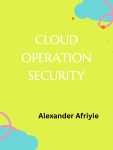Introduction
Welcome to the Cloud Operation Security Training Course! In this course, you will learn the basics of securing cloud operation systems in a variety of areas. This training course will cover topics such as understanding fundamental security concepts, implementing controls to protect data and resources, managing user access and authentication, as well as responding to security incidents. We’ll also discuss best practices for monitoring changes and maintaining compliance with standards and regulations. By the end of this course, you should be equipped with the knowledge necessary to confidently manage cloud operations securely.
Objectives
- Demonstrate an understanding of how to implement and monitor cloud security operations, in order to protect the data stored in a cloud environment.
- Identify potential security risks when utilizing cloud technology and apply appropriate methods for risk mitigation.
- Train staff to develop secure access protocols for cloud services and applications.
- Explain best practices for configuring, monitoring, and maintaining the security of cloud systems and data storage networks.
- Design security policies that align with corporate objectives and reduce the likelihood of malicious activity or unauthorized access to sensitive information/resources stored in the cloud platform.
- Develop strategies for detecting and remediating threats or vulnerabilities associated with the use of cloud services or applications within an organization’s IT infrastructure & network architecture.
Course Outline
Module 1. Introduction to Cloud Computing
-Overview of cloud computing, advantages and risks of using the cloud and different types of cloud services.
-Understanding of how to implement and monitor cloud security operations, in order to protect the data stored in a cloud environment.
-Potential security risks when utilizing cloud technology and apply appropriate methods for risk mitigation
Module 2. Cloud Security Basics
– Understanding security considerations for deploying applications and data in the cloud, as well as operational protocols such as multi-factor authentication, encryption and access control.
Module 3. Compliance Considerations
– Implementing compliance requirements such as GDPR, HIPAA and SOX in the context of public cloud services.
Module 4. Cloud Hardening and Training
-Best practices for configuring cloud-based infrastructure to secure applications and data, including virtualization security controls, secure networks etc.
-Other practices for configuring, monitoring, and maintaining the security of cloud systems and data storage networks
-Train staff to develop secure access protocols for cloud services and applications
– strategies for detecting and remediating threats or vulnerabilities associated with the use of cloud services or applications within an organization’s IT infrastructure & network architecture.
-Design security policies that align with corporate objectives and reduce the likelihood of malicious activity or unauthorized access to sensitive information/resources stored in the cloud platform.
Module 5. Incident Response Planning
-Developing processes for responding to risky events impacting cloud operations such as malware attacks, unauthorized access, or data breaches etc.
Module 6. Monitoring & Auditing Practices
-Setting up monitoring systems to detect potential threats or suspicious activity patterns across all layers of the cloud stack; auditing procedures for verifying compliance with internal policies or regulations.
Module 7. Exams and certification




Reviews
There are no reviews yet.